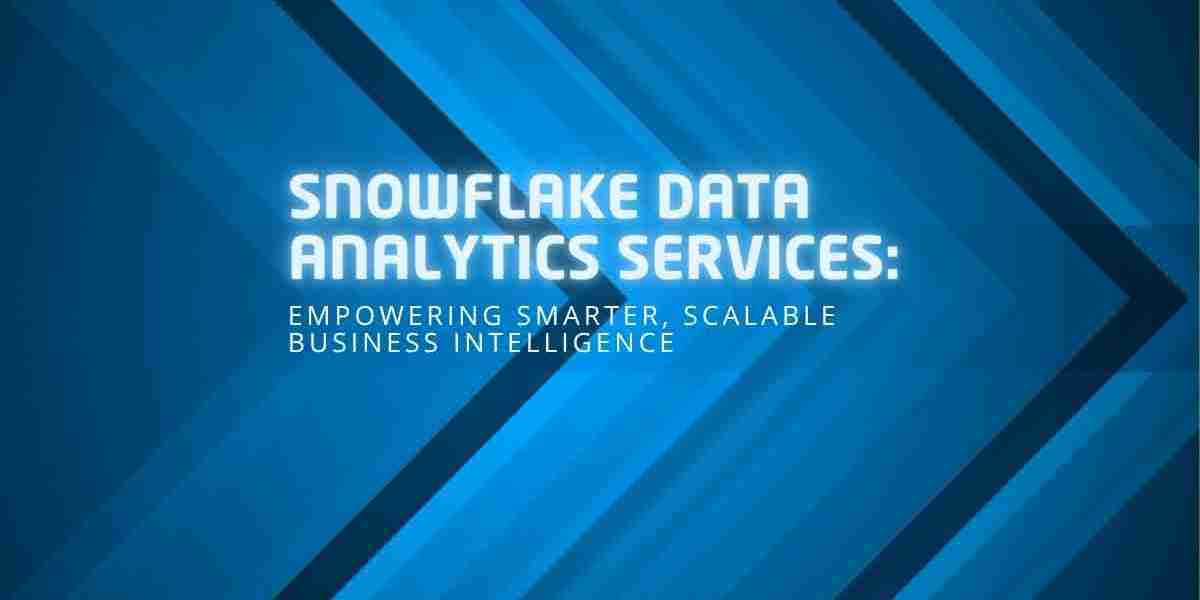In a world where data drives decisions, Snowflake Data Analytics Services are turning heads for all the right reasons. Whether you're running a fast-growing startup or managing enterprise-level operations, data is the heartbeat of everything you do. Snowflake has become one of the go-to solutions for companies wanting to unlock the full potential of their data without worrying about infrastructure, speed, or scalability. Let's dive into how Snowflake makes it happen.
What is Snowflake and Why Should You Care?
At its core, Snowflake is a cloud-based data warehousing platform. But calling it just a “warehouse” would be an understatement. Think of it as your intelligent data butler—it organizes, stores, and fetches data when you need it, how you need it, with blazing speed and top-tier security.
Unlike traditional solutions, Snowflake separates storage and compute, meaning you can scale up or down without performance bottlenecks or sky-high costs. That’s music to any data engineer’s ears.
Key Features That Set Snowflake Apart
1. Cloud-Native Architecture
Snowflake is built from the ground up for the cloud. No on-prem headaches, no outdated hardware. It runs seamlessly on AWS, Azure, and Google Cloud.
2. Multi-Cluster Compute
Say goodbye to resource contention. Snowflake’s multi-cluster compute engine lets different workloads run independently. So your marketing team can run reports without slowing down data science teams.
3. Secure Data Sharing
Need to share data with a partner company or client? Snowflake makes it easy, secure, and real-time. No more CSVs flying around your inbox.
4. Auto-Scaling & Auto-Suspend
Snowflake knows when to ramp things up or slow them down—saving time, effort, and cloud costs.
Why Businesses Love Snowflake Data Analytics Services
Cost-Effective Scalability
You only pay for what you use. Whether you're crunching big data or running small queries, Snowflake’s pay-per-use model fits your budget like a glove.
Speed & Performance
Slow queries are productivity killers. Snowflake delivers sub-second query performance even on massive datasets.
Data Democratization
With Snowflake, everyone—from interns to executives—can explore data. It's intuitive, fast, and doesn’t require you to be an SQL wizard (though it helps!).
How Snowflake Powers Real-World Analytics
Retail Industry
Retailers use Snowflake to track inventory, forecast demand, and analyze customer behavior in real-time.
Healthcare
Hospitals and research institutions manage huge patient datasets while staying HIPAA-compliant, all thanks to Snowflake’s secure platform.
Finance
Banks and fintech companies rely on Snowflake for fraud detection, portfolio analysis, and risk management.
Snowflake's Role in Data Lake and Data Warehouse Integration
Snowflake data analytics services acts like the bridge between structured data warehouses and semi-structured/unstructured data lakes. Whether your data lives in Parquet, JSON, or ORC, Snowflake can ingest and analyze it effortlessly.
Built for the Modern Data Stack
Snowflake plays well with the modern data stack—think dbt, Fivetran, Tableau, Power BI, and more. Its seamless integrations mean you spend less time building pipelines and more time unlocking insights.
Data Governance and Compliance Made Easy
Snowflake provides robust tools for access control, encryption, and activity monitoring. It helps you meet compliance needs for GDPR, HIPAA, and more without breaking a sweat.
AI and ML With Snowflake
Yep, Snowflake isn’t just for analytics. With Snowpark and integrations with tools like DataRobot and Amazon SageMaker, you can build and train machine learning models directly on your data.
Getting Started with Snowflake Data Analytics Services
Step 1: Define Your Objectives
Are you building dashboards, running advanced analytics, or streamlining ETL? Know your goals before diving in.
Step 2: Connect Your Data Sources
Plug in your databases, APIs, apps, and more. Snowflake makes ingestion a breeze.
Step 3: Optimize Your Queries
Use clustering, caching, and proper modeling techniques to get the most bang for your buck.
Step 4: Enable Access Across Teams
Set permissions, roles, and share dashboards. Make sure everyone’s on the same page (and looking at the same data).
Best Practices for Using Snowflake Efficiently
- Leverage Virtual Warehouses Wisely: Allocate compute resources based on workload size.
- Use Materialized Views: Speed up query performance for repetitive analysis.
- Set Up Resource Monitors: Prevent surprise bills by keeping compute usage in check.
- Partition Smartly: Optimize clustering keys for faster scans.
Common Challenges and How to Overcome Them
Learning Curve
Snowflake’s interface is friendly, but mastering its full power takes time. Use training resources, communities, and documentation.
Cost Management
Without proper monitoring, costs can creep up. Set up alerts, budgets, and query optimization policies early on.
Data Governance
Although Snowflake offers great tools, governance is a shared responsibility. Have a plan, define roles, and implement best practices.
Snowflake vs Traditional Data Warehousing
| Feature | Snowflake | Traditional Warehouses |
|---|---|---|
| Scalability | Instant, auto-scaling | Manual, hardware-bound |
| Cost | Pay-per-use | Fixed cost, high CapEx |
| Performance | High | Depends on hardware |
| Maintenance | Minimal (managed service) | High (self-managed) |
| Data Sharing | Real-time, secure | Manual, file-based |
The Future of Snowflake Data Analytics
Snowflake is continuously evolving. With acquisitions and innovations like Snowpark and Native Apps, the platform is expanding beyond warehousing into a full-fledged data cloud ecosystem. The future? Think AI-driven insights, embedded analytics, and more.
Conclusion
Snowflake Data Analytics Services aren't just another data platform—they're a data revolution. With its cloud-native architecture, unbeatable performance, flexible pricing, and seamless integrations, Snowflake empowers businesses of all sizes to do more with their data. Whether you're visualizing KPIs or training ML models, Snowflake gives you the tools to succeed—securely, scalably, and smartly.
FAQs
Q1. Can Snowflake handle real-time data analytics?
Yes, Snowflake supports near real-time data ingestion and analytics through integrations and streaming pipelines.
Q2. Is Snowflake secure enough for sensitive industries like finance or healthcare?
Absolutely. Snowflake complies with industry standards like HIPAA, SOC 2, and GDPR, offering features like data encryption, masking, and access controls.
Q3. What’s the difference between Snowflake and BigQuery?
Both are cloud data platforms, but Snowflake offers better cross-cloud support, workload isolation, and performance tuning flexibility.
Q4. How much does Snowflake cost?
It uses a pay-as-you-go pricing model. Costs depend on storage and compute usage, which you can manage with built-in tools and monitors.
Q5. Do I need a data engineering team to use Snowflake?
While helpful, it’s not mandatory. Snowflake’s user-friendly UI and wide integration options make it accessible for analysts and business users too.




